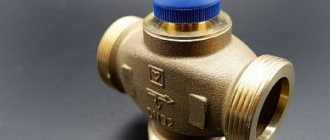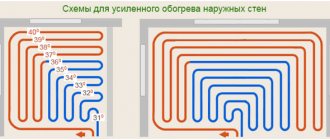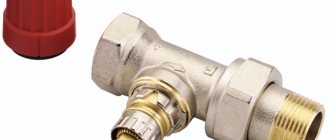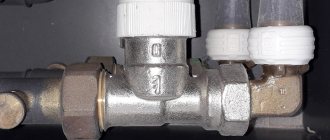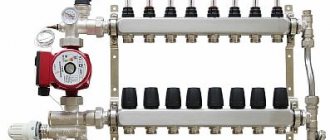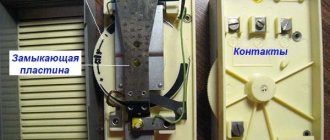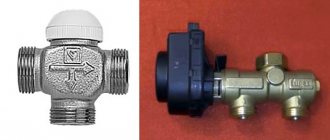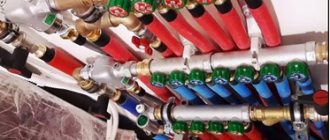When heating premises for any purpose, it is important not only to create a comfortable climate, but also to ensure rational fuel consumption. Thermostatic valves, which are installed in those sections of the thermal circuit where the heat exchangers are connected, help in solving these problems. It is especially convenient to use thermal valves to regulate the heating level of a heated floor.
Types of control valves
Although the purpose of all valves is the same - to distribute the heating level of the coolant in the pipes, they still differ in control methods.
There are the following types of devices:
- manual;
- with electric drive;
- with thermal head;
- pneumatic;
- with hydraulics.
For a private residential building, a three-way valve for heating with an electric drive would be preferable. Changes in the characteristics of the coolant are made thanks to special sensors that transmit commands to the electric drive through the controller.
The desired temperature distribution effect occurs automatically, regardless of what heating equipment is installed in the house - solid fuel, gas or electric boiler.
Thermal valve - the main element of a water heated floor
The device allows you to significantly simplify and optimize the operation of the heating system by adjusting the flow of hot and cold water into the pipeline. Thus, the thermal valve is the element through which the coolant passes. The microclimate in the house essentially depends on its performance.
A simple way to adjust the temperature of a heated floor
Design features of the thermal valve:
The thermal head is a separate unit that is mounted on the valve stem. This part is responsible for adjusting the air temperature by changing the position of the valve box;
Characteristics of the thermal head from the thermal valve
Characteristics of two way valve
The two-way valve is an upgrade to the valve. Built into the collector, it operates automatically and maintains the set temperature level. Unlike a traditional valve, this model is focused on passing liquid flow in one direction. If you install it back, the entire process of functioning of the heated floor will be disrupted. To extend the service life, a filter is installed in front of the valve to retain mechanical impurities.
Thermal mixing unit for heated floors
Two way valve diagram
Thanks to this scheme, the heated floor does not overheat, therefore, its service life is extended. Since the throughput of a two-way valve is relatively low, temperature control is smooth, without jumps. Experts recommend using this device when installing heated floors over a large area exceeding 200 m2.
Installation and connection of the thermostat
Before installation, carefully read the operating instructions for the device. Typically it contains the following installation instructions:
- thermostat height above floor level – 1.5…1.7 m;
- do not place the regulator with an air sensor near sources of heat or cold - heating radiators, air conditioners, ventilation openings;
- technological distance from window and door openings – 1 m (minimum);
- maintain the maximum distance between the thermostat and the distribution manifold of water transformer substations (the cable length is indicated in the instructions);
- the external sensor is located exactly in the middle between the underfloor heating loops at a distance of 500 mm from the wall;
- The floor temperature sensor is mounted inside the corrugated pipe; it should be easily pulled out after pouring the screed.
Surface-mounted devices are screwed directly to the wall, the wiring is laid in grooves. A recess is made under the built-in thermostats, and a regular socket box is installed.
If the cable heating section consumes more power than the thermostat can switch, you need to use a modular contactor in the circuit. The specified actuator is mounted on a standard DIN rail.
Here the thermostat sends a control signal to the contactor, which opens the power line
Some versions of thermostats have a contact for connecting a timer. This solution allows you to reduce the temperature in the room by 5 degrees once a day without purchasing an expensive digital model of the device. The timer circuit is shown below.
The Latin letter L in the diagram indicates the phase wire, N - zero (neutral)
Let's move on to water heated floors. The simplest way is to connect the thermostat to the servo drive directly (in series). Just first find out the type of drive, “normally open” must be connected to the normally open contact of the device, “normally closed” - to the break contact. Often, manufacturers put the appropriate markings on the terminals - NO or NC. The COM contact is common.
To implement multi-zone underfloor heating in a private home with wireless thermostats, use the following circuit diagram. Terminal numbers and other details are not indicated here, since equipment from different manufacturers has different markings.
Watch this video on YouTube
Criteria for choosing thermostats for heated floors
In order to make your heating system as efficient and controllable as possible, you should not neglect expensive device models. In most cases, the choice of device is influenced by living conditions and the intensity of use of heating equipment.
It should be said right away. Mechanical thermostatic valves are simple and convenient. They are usually used in residential areas where people are constantly present. Even in a room where children are, installing such devices is not prohibited. The devices have appropriate protection.
In cases where there is often no one at home, and the need for heating exists constantly, the best option would be to use a programmable thermostat. By setting the necessary time and temperature parameters in advance, you will organize automatic operation of the heated floors. For those who are planning to install heated floors at home, when purchasing a thermostatic regulator, a number of nuances should be taken into account:
- when relying on automated devices, it is necessary to have a constant voltage in the home electrical network;
- the permissible temperature threshold for the thermostat is 60C;
- Installation of devices is carried out in two versions, using a panel installation or wall mounting. The panel mounting option is used in large premises. The wall-mounted version is mounted next to an outlet or electrical panel and is more suitable for working in small spaces.
Design and operating features of the device
Let's look at how a thermostatic valve works and on what principle it works.
How does a thermal valve work?
The device consists of two main working elements - a valve and a thermostatic head. The first is most often made of brass, sometimes nickel-plated, its lower part blocks the pipe, and its upper part continues the pressure rod and spring.
Valves are also available in bronze (nickel-plated or chrome-plated), as well as stainless steel. The latter are rare and expensive.
What happens inside the valve? The head device contains a sensitive element. It is located in a cavity with gas or liquid (bellows).
Heating provokes expansion in this environment, the element is pushed forward, pressing on the rod, spring, and later on the valve. The force of pressure determines the degree of overlap.
DIY valve installation
We present to your attention several schemes for installing a mixing valve.
A scheme that is used mainly in boiler rooms of heating systems that are connected to a hydraulic separator or to a free-flow collector. The pump, which is located in the second circuit, ensures the necessary circulation of the coolant.
Attention! In the case when the valve is planned to be directly connected to the coolant source on the bypass, which is connected to port B, then it will be necessary to install a valve with hydraulic resistance, which will be equivalent to the same resistance of this source
If this is not done, then the coolant flow in the segment A-B will fluctuate depending on the movement of the rod
It is worth noting that this installation scheme provides for a possible interruption of coolant circulation through the source if the installation is made without a circulation pump or hydraulic separator in the main circuit.
If this is not done, then the coolant flow in the segment A-B will fluctuate depending on the movement of the rod. It is worth noting that this installation scheme provides for a possible interruption of coolant circulation through the source if the installation is made without a circulation pump or hydraulic separator in the main circuit.
It is not recommended to connect the valve to a pressure manifold or heating networks in the absence of devices that can throttle excess pressure. Otherwise, the coolant flow will fluctuate seriously.
If the return is overheated, it is allowed to get rid of excess pressure using a jumper, which is mounted parallel to the valve mixture in the circuit.
Carrying out quantitative adjustment by changing fluid flow rates is the main function performed by this three-way thermal valve. It is used where it is possible to bypass liquid to the “return”, but stopping circulation, on the contrary, is extremely undesirable. We also present a diagram for installing a three-way separating valve:
Important! A similar connection scheme has become quite popular in water and air heating units connected from individual boiler houses
In order to link hydraulic circuits, it is necessary that the consumer's pressure losses be equal to the losses on the valve - balancer in the bypass
The diagram shown here should be used for installation on those pipelines in which there is excessive pressure. The movement of liquid is carried out due to strong pressure, which is formed using a circulation pump.
In order to link hydraulic circuits, it is necessary that the consumer's pressure losses be equal to the losses on the valve - balancer in the bypass. The diagram shown here should be used for installation on those pipelines in which there is excessive pressure. The movement of liquid is carried out due to strong pressure, which is formed using a circulation pump.
Equipment characteristics
The coolant from the boiler passes through the pipe line to the collector. From it the liquid flows into the floor pipeline. Giving up heat, it returns back to the collector, which has a separate return outlet for the cooled coolant. The circulation pump forces water back into the boiler.
When manually controlling the temperature regime, valves are installed on the circuit with cold water and high-temperature coolant. If the room has warmed up well enough, then the hot water valve is closed. If the room is cold, the valve is opened.
To automatically regulate the heating mode, install a three-way mixer with a thermostat and an external temperature sensor. This system forms a thermostatic valve. It is installed at the entrance to the collector. The equipment is made of brass or bronze.
- The three-way valve has 3 outlets for hot, cold water and coolant, which is supplied to the floor line. Markers on the body indicate the direction of flows of different temperatures.
- A mixing chamber is provided to mix liquids of different temperatures.
- On the body there is a thermostat with a temperature regulator.
- The temperature sensor is located on the thermostat.
- The valves close the outlets for cold and hot flow. They can be disc-shaped or needle-shaped. Their operation depends on the thermostat.
- The thermostat is a system that consists of a capsule with liquid and a spring-loaded rod. Valves are attached to it.
- The temperature sensor has a digital panel on which the heating modes are indicated.
We recommend: What characteristics does a two-core heated floor have?
The thermostat can be located in the thermal head or in the servo drive. The devices have different circuits, but the same principle of operation. The thermal head is a thermostat, the operation of which is carried out using a liquid: it is sensitive to temperature changes.
Servo drives operate from the electrical network. The liquid is contained in a container. It contains a heating plate. The servo drive is installed on the manifold.
The three-way mixer is designed for heating systems of large areas. In separate rooms or in country houses, a two-way valve is connected to the collector. It is installed on a circuit with a high temperature coolant. Water flows through it in only one direction.
Are thermal heads needed on radiators - our experience of two years of use
The heating in our house has been working for 2 years, although this is our first winter. Last winter we were finishing and building the stairs. The heating was turned on to the bare minimum to save energy. Nevertheless, we felt comfortable working.
Thermal heads are installed on every radiator in the house; they automatically maintain a comfortable temperature in the room. This is due to the fact that the thermal head inside has a spring valve and a sensitive thermoelement, which has a large expansion when heated.
If the room becomes hot, that is, the temperature rises above a comfortable one, the valve closes the passage for the coolant fluid, and the battery cools. But, of course, for this you need to adjust all the batteries so that the temperature is exactly what is required.
It is easy to verify that this system works. At night we always ventilate the rooms and if after airing you touch the batteries, they are simply very hot, so much so that it is impossible to touch. And on frosty but sunny days, when the sun through the windows heats the rooms, the radiators become barely warm. Of course, this leads to significant energy savings.
Thermal heads are manual, mechanical and electronic. Manual, these are just taps with divisions, as you turn them, that’s how they stand. Mechanical ones have a thermocouple, which I already talked about. They work independently, but within a given range.
Electronic thermal heads are small computers that can be set to any parameters and programmed by time of day, day of the week, and so on. Of course, they are quite expensive and are unlikely to pay off due to savings on heating the coolant. The best option is, of course, mechanical thermal heads.
When using these devices, it is tedious to take into account that they require free air circulation around them. Therefore, it is impossible to obscure them with furniture, curtains, or protruding window sills. They will not work properly under these conditions. For example, behind the curtains they will be cold from the window, and they will increase the temperature. And under the windowsill they will be hot, and the temperature will drop, the room will always be cold.
Thus, if someone decides to install thermal heads, this is a completely profitable and comfortable thing. You just need to strictly follow the instructions and act wisely.
What disadvantages do I note in thermostats?
Firstly,
the price. For example, “Buderus” today sells for 1,500 rubles. Two years ago, of course, they were cheaper. But if there are 10 radiators in the house, then this is 15 thousand rubles - a rather large amount. You can also find it cheaper. Although this is not something you should skimp on.
How to choose
The thermostat is selected according to the operating characteristics of the heating system. The device must:
- Withstand pressure in the range of 16–40 bar and temperatures up to 200 °C.
- Be made of corrosion-resistant materials that are resistant to mechanical stress.
- Match the diameter with the size of the pipeline.
- Match the thread parameters on the pipe.
Popular manufacturers
Thermostats manufactured by the following companies are considered the most reliable and durable:
Danfoss (Denmark). Devices from this manufacturer, despite their fairly low price, have an improved design. They are equipped with a flow stabilizer, so they operate silently. They do not become clogged when working with any contaminated coolant, since their rod stroke is 1.5 times greater, and the performance adjustment window has a larger cross-section.
Oventrop (Germany). The variety of standard sizes of thermostatic fittings from Oventrop allows you to choose the ideal model for any engineering system. Excellent regulating qualities, high product reliability are combined with an aesthetic appearance.
Luxor (Italy). Luxor thermostats are suitable for heating systems where the coolant is hot water. They are equipped with a thermostatic spindle that allows pre-setting of the flow.
Service life of three-way valves
The most important factors affecting the service life of a three-way valve:
- The material from which it is made.
- Compliance with the operating conditions prescribed by the manufacturer - temperature conditions and coolant quality.
- Intensity of use.
- Installation quality.
On average, manufacturers provide a guarantee for their products ranging from 5 to 7 years, which means that a three-way valve can easily work 2 times longer. But the warranty for plastic models does not exceed 1 year.
The valves with a manual control system have always been recognized as the most reliable. Electronic and thermostatic sensors fail much faster than the valve itself and require repair or complete replacement.
Variety of water floor structure regulators
The fundamental difference between different control devices lies in the method of setting the required temperature:
- Mechanical modifications. These devices rarely break down and are affordable. This type of water heated floor regulator has a simple scale that makes the setting process easy and understandable. The required temperature is set using a rotating disk. Sometimes on the front panel of thermostats for heated water floors there is a lever designed to turn it on/off. These devices have no other functions. The average price for them is 15 euros.
- Electronic devices. Their functionality is similar to the mechanical version, but it is implemented differently. The electronic model provides a digital screen on which current or set parameters are displayed. You can also see several buttons on the devices. They may contain arrows with “up” and “down” signs, which serve to gradually change the temperature regime. Estimated cost – 20 euros.
- Models with programming. Adjusting the temperature of a heated floor using such a device allows you to both maintain stable heating and change it automatically depending on time. Models are sold that have the ability to program the temperature during the day and by day of the week. This function allows you to save energy resources, and therefore money, and at the same time live in comfortable conditions. For example, the temperature can be lowered when all family members are away from home, and raised before they return. Some modifications, in addition to the stationary unit located on the wall, are equipped with portable control panels. There are now models on sale that can be used to correct work using a computer or tablet. The simplest modification, which provides the ability to set the floor temperature over time, will cost no less than 40 euros, and a sophisticated device can cost more than one thousand.
- Multizone modifications. Such thermostats control several circuits and maintain individual parameters in each of them.
- Touch models. The list of functions performed by these devices is the same as that of electronic models. But they are equipped with touch buttons, not tactile ones. The cost is higher.
- Radio thermostats and controllers. Similar systems supplied by European manufacturers are new to the domestic market. For example, Uponor systems consist of servomechanisms controlled using radio signals, a radio thermostat that monitors sensor readings, and a radio controller that receives data from the thermostat and transmits it further to servos. The kit also includes an SMS module that allows you to control the system via mobile communications and monitor its status.
Control valves for radiators
To manually regulate the operation of heating devices, special valves are used. Such taps are sold with straight or angular connections. The procedure for regulating heating batteries using these devices manually is as follows.
When the valve is turned, the shut-off cone lowers or rises. In the closed position, the coolant flow is completely blocked. Moving up or down, the cone regulates to a greater or lesser extent the amount of circulating water.
Due to this operating principle, such valves are also called “mechanical temperature controllers”. They are installed on batteries with threads, and connected to pipes with fittings, most often of the crimp type.
The control valve used for heating devices has the following advantages:
- the device is reliable, it is not dangerous from blockages and fine abrasive particles present in the coolant - this applies exclusively to high-quality products in which the valve cone is made of metal and carefully processed;
- the product has an affordable price.
Control valves also have disadvantages - each time you use the device, its position has to be changed manually and for this reason it is quite problematic to maintain a stable temperature regime.
For those who are not satisfied with this procedure and are thinking about how to regulate the temperature of the radiator using another method, the use of automatic products that allow them to control the degree of heating of the radiators is more suitable.
Adjustment mechanism
Thermostatic mixing valve
A thermostatic mixing valve is also used in radiator-type heating schemes, but convective air circulation (even with balanced ventilation and careful insulation) still leaves the lower layers as the coldest part of the room.
The source of thermal energy can be either a central heating plant or an autonomous boiler. In any case, boilers operate effectively in stable modes and will not provide smooth adjustment of coolant flow in each individual room.
For this purpose, special fittings with selected operating parameters and a specific type of design are included in the system. Installing a mixing valve for underfloor heating gives the following stabilizing result in normalizing the temperature in the house:
Mixing valves perform the task of combining a high-temperature heating circuit with a low-temperature underfloor heating distribution, since the recommended temperature in the pipes under the floor is 40°C, and for the water leaving the boiler 70 - 90°C.
Work principles
If the coolant is too hot, a cold stream is mixed into the water
The three-way valve for heated floors performs its function in the following order:
- the hot coolant from the boiler is directed to the distribution manifold, from which it diverges through the loops of the underfloor heating system;
- a thermo-mixing valve is installed along the path of movement, reacting to the heating temperature of the water;
- when the flow temperature exceeds the set value on the regulator, the latter opens a passage for mixing cooled water from the return pipeline;
- in the tee, two converging flows are mixed and the coolant of the desired temperature is released into the system;
- When balance is achieved, the change in the internal sections of the valve stops.
The valve body is made of brass and consists of 3 channels converging to the adjustment mechanism. The use of 3 different methods of mixing water flows distinguishes 3 types of three-way valve designs.
Three way thermostat
The thermostat mixes hot and cold flow
The set temperature is maintained by a three-way thermostatic valve, which automatically mixes the hot liquid flow from the heater and cooled water from the return pipeline. The need for quantitative changes in flows is determined by the thermostat settings.
This product can be used in underfloor heating systems (especially complex configurations), on radiator wiring and in the internal hot water supply circuit.
Automatic change in the temperature of the outgoing coolant protects a person from elevated temperatures in the event of a pipe rupture. If for some reason the flow of cold water stops, the valve will automatically close the flow of hot pressure from the boiler. The temperature-sensitive unit responds to the amount of heating and, accordingly, changes the cross-section of the inlet holes, achieving the required balance.
The layout of the thermostatic valve for a heated floor looks like this:
A pressure throttle is a device that provides fluid pressure regardless of the pressure difference at the inlet and outlet. Paired with a thermal head for a heated floor, it stabilizes the operation of all system circuits when incoming conditions change.
3-way thermostatic valve
The operation of this valve is not as complicated as a thermostat. Only the incoming hot media is regulated. For more information about the operation of three-way valves, watch this video:
To analyze changes in temperature indicators, the kit includes a thermal head for heated floors, which acts as an executive body based on a signal from an external sensor.
Mixing valve
Manual valve adjusted manually
The three-way mixing valve, which is not equipped with sensors and automation, is even simpler. The manual valve needs to be forced to set the position of the regulator to obtain the desired outlet temperature.
This crane is manufactured in 2 types:
- has a T-shaped passage (symmetrical design);
- internal L-shaped passage, (asymmetrical).
The differences are that with a symmetrical scheme, 2 jets meet from opposite arms of the valve and go into the side branch already in a mixed state.
Drive types
During operation, the three-way valve is controlled by temperature by an external drive; it comes in several types:
- A simple thermostatic actuator presses on the rod due to the expansion of the liquid medium placed in it, which is sensitive to changes in temperature. Typically, household three-way thermostatic mixing valves of small diameters are initially equipped with this type of actuator; it can be easily removed to install another type of device.
- Instead of a standard drive, the tap can be controlled by a thermostatic head, which has its own sensitive element that responds to the ambient temperature. To regulate the water temperature, the three-way mixing valve with a thermal head is additionally equipped with a remote temperature sensor. The latter is placed in a pipeline with a coolant and connected to the drive by a capillary tube. Such regulation is more precise.
- An electric drive controlled by a controller can also act on the rod. Electrical sensors, called temperature transducers, continuously measure the parameters of the coolant and signal their exceedance to the controller, on which the operation of the three-way valve with electric drive depends. The most common and most accurate method of regulation.
- A simplified version of the previous type of product is a three-way mixing valve with a servo drive. The difference lies in the absence of a controller; the drive controls the faucet directly, receiving signals from the temperature sensor. Most often used in conjunction with three-way valves with a ball or sector distribution element.
Subtleties of installing a thermostatic mixing valve
The three-way mixing valve can be installed in heating systems with one or more circuits by placing it in the mixing unit. It is noteworthy that the connection diagram for a three-way valve for a heated floor will not change depending on the number of circuits (read: “How a three-way mixing valve for a heated floor works, types, application”). The only difference is that the system will be equipped with additional parts.
Additional circuits are needed just to connect the warm water floor pipes to the heating
Please note that according to the connection diagram for a heated floor with a three-way valve, it is mounted in front of the pressure pump. This is a prerequisite for the high-quality functioning of the heating system.
When performing tapping work, it is important to ensure that the valve is not clogged with slag or splashes of molten metal left by the welding machine. In addition, the valve must be removable so that it can be checked and, if necessary, replaced. If you do not have the appropriate skills, it is better to entrust the insertion of the control valve to professionals.
If you do not have the appropriate skills, it is better to leave the tapping of the control valve to professionals.
Classification of thermostatic valves
There are quite a few types and types of thermal valves, but they all have a common structure:
- body - coupling or tee,
- valve - a regulating or closing mechanism,
- valve with thermostat - control mechanism.
Thermostatic fittings are classified according to several parameters:
- body design,
- placement of the control valve,
- purpose,
- flow control method
- control method.
Based on the body design, the following types of thermostatic valves are distinguished:
- straight,
- angular,
- three-way.
The body of a straight and angular thermal valve is a straight and angular coupling, respectively, the body of a three-way valve is a tee.
The placement of the control valve can be:
- axial - the valve is located opposite one of the pipes on its extension, the valve is called axial;
- side - the valve is located perpendicular to the body, on the side; a valve with a side valve has no additional name and is called only by the shape of the body.
We recommend that you read: How to make scaffolding from a profile - drawings and instructions
Thermal valves are classified according to their purpose:
- radiator – for connecting heat exchange devices,
- mixing or mixing - for adjusting the pressure and temperature of water in water taps and “warm floor” systems,
- switching – to change the direction of flow of the working fluid in heating and water supply circuits,
- separation – for distributing the working medium into two streams.
Flow control methods determine the following classification of balancing valves:
- adjustable or open valves - you can adjust the pressure and temperature at any time, the valve is controlled without special keys;
- closed or pre-setting valves - the parameters of the working environment are set during installation of the system; to reconfigure them, a specialist and a set of special tools are required.
Depending on the control method, thermal valves are distinguished:
- manual – adjustment is made by rotating the valve,
- automatic – equipped with a thermal head that responds to changes in temperature and pressure of the coolant,
- remote control – equipped with a remote thermocouple that responds to changes in room temperature, with the ability to configure the optimal range.
Principle of operation
The coolant circulates in the device body, in the front and right pipes, until its temperature reaches the set value. The thermostatic valve is installed to maintain a set outlet temperature by mixing cold or hot water into the liquid. If the parameters do not converge, then the external drive of the device acts on the rod. When it starts to move, all 3 channels in the housing open. And, as soon as the temperature parameters stabilize, the front inlet pipe is closed.
There is a wide variety of thermostatic valves and three-way valves. One of the varieties is similar to a ball valve. In this model, the switch valve consists of a ball with a recess rather than a seat with a cone. To redistribute the coolant, the drive acts on the rod with the attached ball, rotating it. Such valves have a low throughput, so they are used only in domestic heating systems. In short, the thermostatic valve sets the desired water temperature.
The principle of operation in the heating system - how the device works
To put it simply, the operating principle of a three-way valve is to mix water heated to different temperatures. At the same time, fuel savings are achieved, and the boiler operates more efficiently and is not subjected to unnecessary loads.
While the water circulates through the heating pipes, it gradually cools down. Therefore, answering the question why a three-way valve is needed for heating, let’s say that it allows you to dilute cold and hot water so that it is reheated by the boiler more quickly and easily.
In addition, hot water flows are distributed throughout the system, and in order not to do this manually, an electric drive is installed. It automatically controls the flow, controlling the degree of heating of the coolant. The durability and efficiency of the heating system depends on the quality of this part.
Features of choosing mixing units
Piping of the boiler and other components of the heating system is always done with standardized pipes. At the same time, each developer tries to use threaded connections of the same standard size throughout the entire pipe structure. Here, a design feature of the three-way valve may appear that may prevent the system from operating efficiently and reliably.
Despite the fact that the threaded connection diameter of the mixing unit can be quite significant, this does not indicate the actual throughput. The problem is that the inner diameter of the holes that are blocked by the control head or ball can be 4 or more times smaller than the connecting pipe. Therefore, it is imperative to review the technical documentation in the store.
The key parameter that should be taken into account when choosing a particular product is throughput. Qualified heating system developers are able to provide such a figure for guidance. But if everything was done “by eye,” you need to focus on the performance of the heating boiler. The amount of water it is capable of producing per hour or minute must be compared to the flow capacity of the valve.
Technical Specifications of Three-Way Valve
Where should a 3-way valve be installed and when is it not needed?
Before selecting a three-way valve, it is advisable to make sure that it is really necessary. After all, on the Internet and in real life there are enough advisers who poorly understand the essence of the issue. So, let's list the situations when this valve is really needed:
- To protect the solid fuel boiler from the supply of cold coolant and condensation on the internal walls of the firebox.
- To regulate the water temperature in heating circuits.
- To limit the heating of the coolant in underfloor heating circuits.
A lot has been said about condensate, which provokes the formation of sticky growths on the walls of the TT boiler chamber, including. It appears during the heating process, when the temperature in the firebox is already high, and cold water comes from the heating system. To avoid this, the supply and return lines are connected by a bypass, where a 3-way valve is installed. It forces the coolant from the boiler tank to flow in a small circle, and only when heated to 50-60 °C does it begin to add water from the system.
Regulating the temperature in heating circuits using a mixing unit is necessary in the following cases:
- in complex heating systems, when several lines with different temperature conditions must be connected to a common comb, for example, a radiator network, heated floors and an indirect heating boiler;
- when connecting the same consumers to a buffer tank - a heat accumulator;
- when supplying heated water to the heat exchanger of a ventilation air handling unit used for air heating of a country cottage.
Since a coolant with a temperature of no more than 50 °C is sent to the heating circuits of heated floors, and 85 °C can be supplied from the boiler, this should be limited. Usually (but not always!) the issue is resolved by installing a mixing unit with a 3-way valve on the distribution manifold. The latter mixes chilled water from the floor circuits with the “external” coolant coming from the boiler.
Now let’s identify situations where the purchase and installation of a mixer (or separator) is not necessary:
- If the length of each loop of a water heated floor does not exceed 50-60 m, which is quite possible to achieve, then regulation is done without a mixing unit. Instead, RTL type heads are installed on the return manifold, limiting the flow by the amount of coolant.
- When 2-3 heating units alternately operate to heat a private house, maintaining a constant network temperature of at least 40 °C, then there is no need to install a three-way valve for a solid fuel boiler.
- In heating systems with natural water circulation. The reason is the pressure drop across the valve, which prevents the movement of coolant. The same applies to heat accumulators operated according to a gravity flow scheme.
If you are interested in why it is better to choose RTL heads and how they control underfloor heating circuits, watch the video from an experienced master and our expert Vladimir Sukhorukov:
Balancing Valve Installation
Thermostatic balancing valve is designed for hydraulic adjustment of the heating system. It ensures a uniform supply of water to all heating devices. In addition, it is installed on a small piping circuit of solid fuel boilers if it is closed to a buffer tank. With its help, the temperature in the circuit is maintained at least 60 0 C, and there is no need to install a mixing unit. In such a scheme, the flow rate of the small circuit must exceed the flow rate of the heating circuit. This is provided by the valve installed on the supply.
Thermostatic balancing valves for hydraulic adjustment of heating systems
The best option would be to install a thermostatic balancing valve on each circuit, including underfloor heating and hot water supply.
Conclusions and useful video on the topic
What is a thermal head, what is it for and how does it work.
Analysis of a finished system with a thermostatic valve.
An experiment on the response speed of thermal heads from 4 manufacturers.
The use of thermal valves for radiators allows you to make your heating system as flexible as possible.
With their help, you can regulate the temperature of individual batteries so as to constantly maintain a comfortable microclimate in the room
But at the same time, it is important to take into account the appropriateness of installing such devices and correctly installing and configuring them.
Are you thinking about installing a thermal valve, but want to clarify a couple of installation points? Ask your questions under this article - our experts and site visitors who use such temperature control equipment will try to answer you in as much detail as possible.
If your heating system is equipped with thermostatic valves, please share your opinion with other users. Tell us, which manufacturer’s equipment did you prefer, is it convenient to use, are you satisfied with the result? Write your recommendations in the block, add unique photos of the thermal valve.
Types of thermostats
The choice of thermostat for a particular system is determined by the following factors:
- equipment power;
- method of regulation;
- functions performed;
- type of installation.
Power
For most equipment, 3 kW is sufficient. If there are a large number of heating circuits, several thermostats are used, or a magnetic starter is installed. The larger the area of the room, the longer it takes to warm it up from one thermostat.
What types of sensors are there?
Different systems are responsible for comfortable floor temperature and air heating. Accordingly, different sensors are used. In the first case, a floor sensor is used. It is placed in a screed between the circuit pipes, at a distance of more than 50 cm from the wall. A pipe or corrugated hose is attached to the floor, into which a cable with a sensor at the end is inserted. The pipe is filled with solution, but its end comes out. If necessary, the failed sensor is pulled out by the wires and replaced with a working one.
An external sensor located in the room is responsible for heating the air. It is usually installed inside the thermostat housing. However, it should not be in a draft, heated by the sun's rays or located close to devices that generate heat.
A groove is made under the sensor in the wall, going to the floor level. A hose is placed in the groove, which is then brought out at one end to the measurement site, and at the other end it is inserted into the installation box with a thermostat fixed in it. The hose is isolated from the solution with a plug. A floor temperature sensor with wires is inserted into it.
You should first check its serviceability by measuring the resistance and then comparing it with the passport data. If a large difference appears, the sensor should be replaced. Then the necessary connections are made. A test run of the system is carried out before pouring the screed.
The indoor microclimate significantly depends on the weather outside. In this regard, a climate control mode has been developed using an external sensor and controller (climate compensator). The program includes a number of dependencies between the temperature of the coolant and the outside air. By selecting one of them based on the outside air temperature, the controller calculates how much the coolant should be heated.
If the calculated coolant temperature is less than the actual temperature, a signal is sent to shut off the supply of hot water to the heating circuit. All measurements and adjustments to coolant flow continue in the direction of reducing data mismatch. The controller can also control the performance of the mixing pump or switch to another mode.
